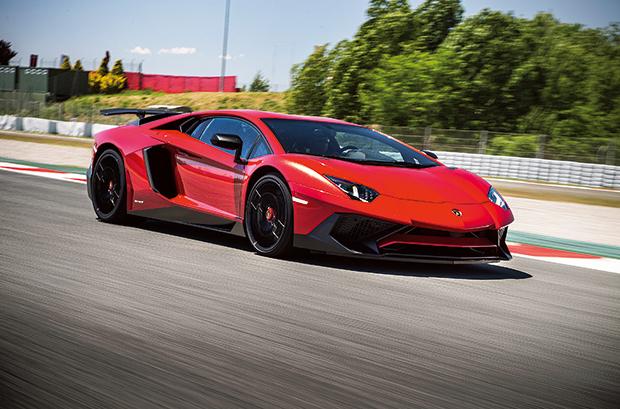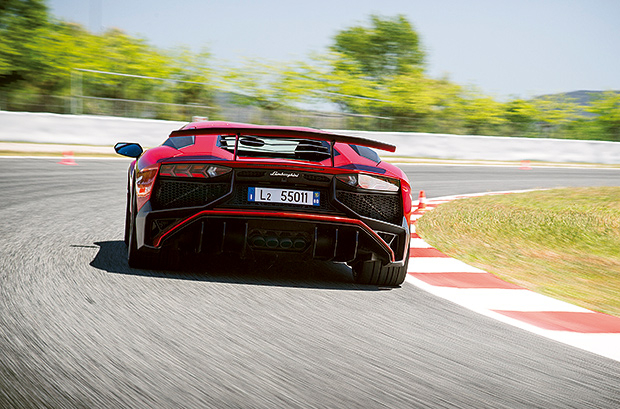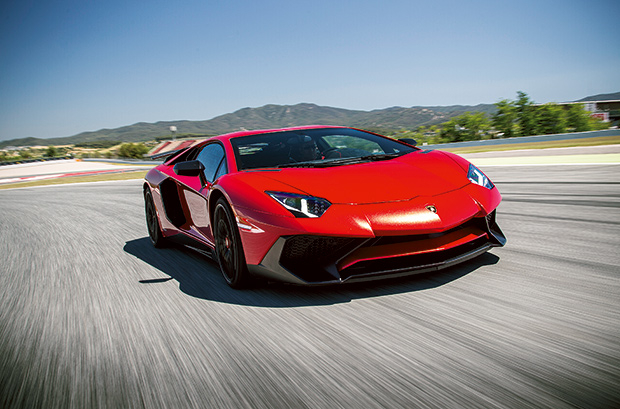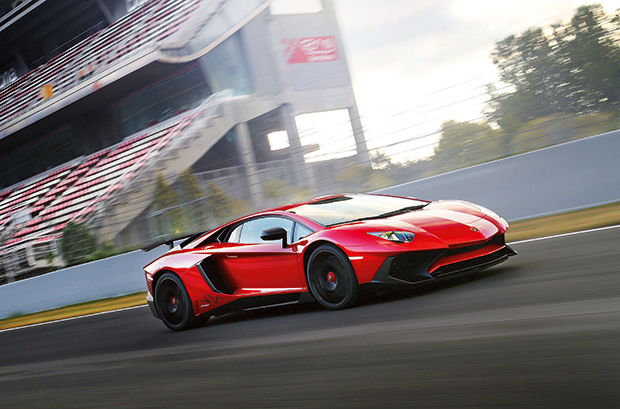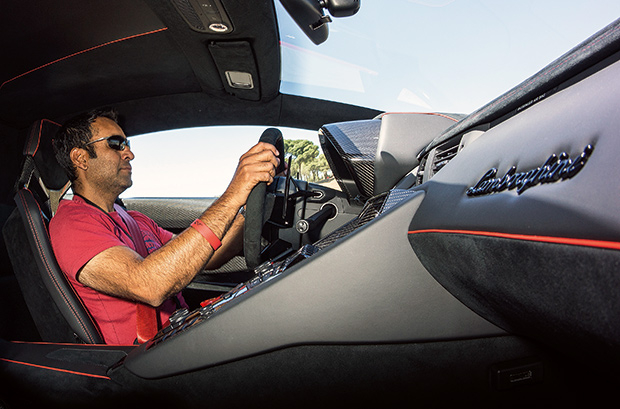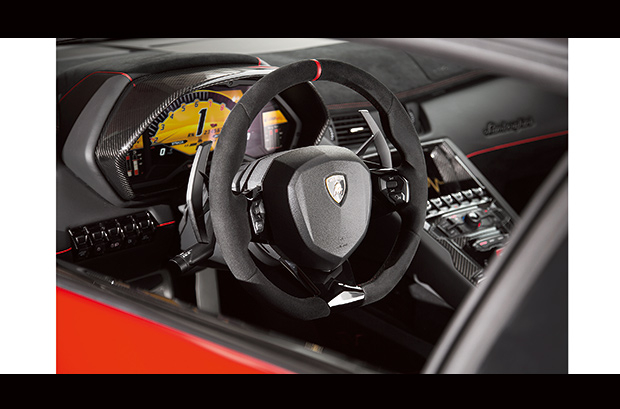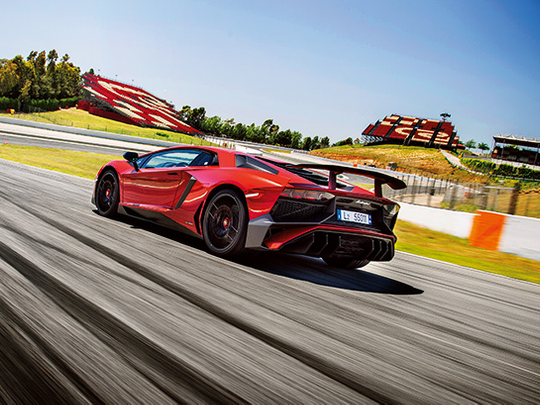
The Aventador LP 750-4 Superveloce is the new ‘big dawg’ of the Lambo line-up, and there has never been a more rapid road car to emerge from the Raging Bull’s skunkworks in Sant’Agata Bolognese. Just 600 units will be built — of which 500-plus are said to be already pre-sold — with Middle East pricing set around the Dh1.8-million mark.
Consider this, the only road-legal cars to have lapped the perilous 20.8km Nürburgring Nordschleife in under seven minutes are the $1 million-plus Porsche 918 Spyder and the McLaren P1 (although the Woking mob have never come clean with an actual lap time; all they’ve said is that the P1 has done the job in “under seven minutes”. Right, we believe you then… cough).
In this context, the Aventador SV’s six-minute-and-59.73-second lap is a genuinely eyebrow-raising feat as it places it virtually 10 seconds clear of the Nissan GT-R Nismo, easily the best of the rest in the supercar pecking order at the ’Ring.
In fact, Lambo’s R&D chief Mauricio Reggiani claims the SV is capable of going a couple of seconds quicker still, as he says the current benchmark is the result of single flying lap, during which test driver Marco Mapelli got the car out of shape on three or four occasions (not hard to do when you’re trying to lay down 690Nm out of some decidedly tricky corners, even though Mapelli knows the Nordschleife and the Aventador SV intimately). Stats are sometimes misleading, but rest assured the LP 750-4 is weapons-grade quick. It’s the fastest thing I’ve driven around any racetrack (apart from a Renault F1 car — yes, the real thing — in which I scored two laps around Paul Ricard back in 2007).
However, the real beauty of the latest Lambo Superveloce is that it isn’t anywhere near as intimidating to push to the limits as its Murciélago LP 670-4 SV predecessor, which always came across as though it wanted to bite your head off and spit it out in disdain.
In contrast, the Aventador SV is much more predictable in its behaviour, thanks to a far superior suspension/chassis set-up, as well as a more sophisticated stability-control safety net, which operates virtually invisibly in Corsa mode. More on this later.
Although the trusty “reduce weight, add power” motto is at the core of the Aventador SV’s performance upgrades, the changes run deeper than that. Lambo’s engineering team set out to enhance virtually every mechanical and aero facet of the car, and the Nürburgring lap time and our seat-of-the-pants impressions after giving it the beans on the nearly 4.7km Circuit de Barcelona-Catalunya (where the Spanish GP had taken place a couple of weeks earlier), suggest their efforts haven’t been in vain.
The mighty 6.5-litre V12 is hardly a shrinking violet in the standard Aventador, but in the SV it scores a 200rpm higher redline (it’s up from 8,300 to 8,500rpm), while peak power rises from 700PS to 750PS (739bhp). The keys to these higher figures are optimised variable valve timing and variable intake systems, as well as a raucous new free-flow exhaust system that exits via four round tailpipes, rather than the single hexagonal drainpipe worn by the regular Aventador.
The 50kg weight saving (yielding a dry weight of 1,525kg) was reaped via extensive use of carbon fibre, an area in which Lamborghini prides itself as a pioneer among carmakers (just as an aside, Lambo makes its own carbon fibre monocell for the Aventador, whereas the likes of McLaren and Ferrari source theirs from external suppliers). As if to trumpet this fact, the carbon fibre monocoque has been left visible in various parts in the LP 750-4 Superveloce.
One of the areas where a decent chunk of weight was saved in the Aventador SV is in the carbon fibre seat shells, which are upholstered in a brand-new ‘Carbon Skin’ material that’s soft to the touch yet light and hard-wearing. A further mass reduction comes from turfing the infotainment system (it can be fitted as a no-cost option), along with the carpets and some sound-deadening material. The aero side of things was addressed via a new front wing, huge rear diffuser and high-mount rear wing with three manually adjustable settings, increasing total downforce by 170 per cent over the stock Aventador. These enhancements also make the Aventador SV look absolutely evil, appearing more FIA GT racer than something you’d expect to see cruising down Shaikh Zayed Road on any given day.
Other noteworthy changes include the addition of magnetorheological dampers to the pushrod suspension, which theoretically enables the car to respond quicker and more precisely to changes in cornering load and road-surface imperfections. There’s also new adaptive steering, which requires you to feed in less lock through tight corners, as well as updated software for the ISR sequential gearbox to make for faster, smoother shifts. Rounding out the upgrades is a bespoke set of Pirelli Corsa P-Zero boots to help the Lambo cling to the tarmac with the tenacity of a terrier that’s attacking your trouser leg.
So much for the theory, what we’re here to find out is whether the SV is a cohesive and worthy improvement over the regular Aventador, or merely a cobbled-together go-faster special that doesn’t quite cut it as an overall package.
A dozen laps around a racetrack don’t provide conclusive proof of a car’s brilliance — or otherwise — but in this case they provided me with enough conviction to declare that the Aventador SV is nothing short of epic.
Wriggling your frame through the narrow aperture between the scissor door and winged seats calls for a measure of athleticism, but, once in place, you immediately feel at home in the Aventador’s cockpit. Yes, lateral and rear visibility isn’t great, but it’s not terrible either. The seating position is top-notch, and all the controls are tactile and thoughtfully placed.
I’m not sure I like the bright yellow TFT instrument cluster — it’s a bit video-game-esque for my tastes — but at least it livens up the dashboard and makes it easy to take in a rev reading with no more than a quick glance at the large analogue tacho that dominates the display. There’s even a racecar-style G-force graphic, although I never quite managed to monitor this on track.
The big V12 fires up without assaulting your eardrums and it immediately settles into a smooth idle. Engage first gear via the flappy paddle and the SV pulls away smoothly too.
As per the standard Aventador, there are three modes that tailor suspension, drivetrain, steering and stability-control settings — Strada, Sport and Corsa — and the latter two are obviously more appropriate for trackwork, as the first setting is best suited to dawdling around the ’burbs or relaxed cruising on the freeway. In Sport mode the seven-speed transmission self-shifts, but in Corsa you need to execute your own changes.
Immediately evident is that the single-clutch ISR gearbox lacks the whip-crack immediacy and seamlessness of the sublime dual-clutch ’box in the Ferrari F12. There’s a brief pause on upshifts, following which the next gear engages with mule-kick violence. It’s dramatic and even a bit enjoyable, but you sense this is one element that holds the car from being an absolutely flawless track weapon.
That said, I was later cruising at gentle pace in Strada mode for car-to-car photography, and was pleasantly surprised to glean how much smoother the transmission is in its latest guise compared with the first Aventador I drove a few years ago. Relaxed inner-city progress was simply not possible in that car as each gear engaged with an uncomfortable jolt at low speeds. It’s all down to new transmission software, and this will filter through to even the regular Aventador from now on.
No criticisms of the new adaptive steering though. It’s simply brilliant in terms of feel, precision and weighting. The thought of jumping into a 739bhp supercar and wringing its neck around a track I’d never driven before may have seemed a tad daunting at the outset, but it wasn’t once we were under way. Credit is also due to the fine chassis tuning of the Aventador SV, and the magnetorheological dampers play their part here.
The Aventador SV turns in with real crispness and stays nicely balanced through not only the tighter stuff but also the selection of long sweepers at Circuit de Barcelona-Catalunya. Grip levels are high enough to give your core muscles a decent workout (my body still aches in parts, even though it’s now been two days since the drive). A four-point harness in lieu of the lap-sash belt would probably be a good idea if you plan on doing regular trackwork as it would lessen the need for you to brace against the seat’s side bolsters when cornering.
Although equipped with permanent all-wheel-drive, the Aventador SV has a distinct rear-biased feel, and it is possible to indulge in some tail-out fun (Corsa mode gives you some latitude for this). It all happens in much more predictable fashion than the Murcie SV, and even when the car got a bit ‘loose’ (it was actually an unintentional drift at 160kph-plus) through the high-speed Turn 3 on one of my laps, it wasn’t an “Oh crap” moment.
As you’d expect with 739bhp and 690Nm on tap, straights are devoured in double-quick time (Lambo quotes a 0-100kph split of 2.8 seconds and top whack of 350kph-plus), and you also arrive at corners carrying more velocity than you would in any other road car. But the big carbon-ceramic stoppers wipe off speed with impunity, and even after sustained hot-lappery at the hands of the assembled journos, the brakes remained pretty much fade-free and the pedal hadn’t gone mushy.
Although the V12’s peak torque figure of 690Nm doesn’t come on tap until 5,500rpm, there is meaningful urge from just 2,000rpm, which means you can use a gear higher than you might have imagined for some corners. An abundance of low-down torque and “emotive sound” is why Lambo insists it sticks with atmo engines, but it can only be a matter of time before the company is forced to go down the turbocharging route, as Ferrari is now doing with the California T and 488 GTB.
For the time being, we should celebrate one of the last old-school — yet new-age — supercars in the Aventador LP 750-4 Superveloce. It is a simply magnificent track weapon that we imagine will also be formidable on the right road out in the real world.
What a shame a number of people who buy it will be doing so purely for its exclusivity and retina-smacking visuals. Then again, it’s their money, so they can darn well spend it any way they like.


